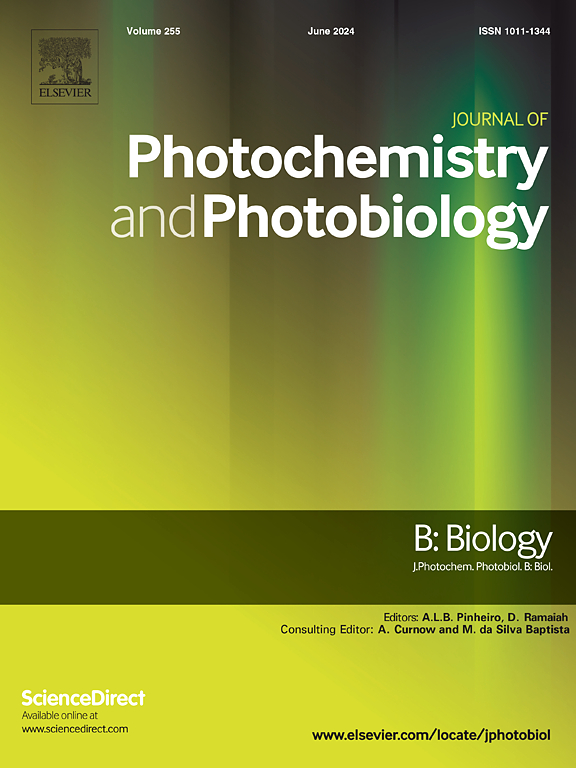Integrated laser speckle contrast and multispectral imaging for in vivo multimodal assessment of small intestinal viability
IF 3.7
2区 生物学
Q2 BIOCHEMISTRY & MOLECULAR BIOLOGY
Journal of photochemistry and photobiology. B, Biology
Pub Date : 2025-09-11
DOI:10.1016/j.jphotobiol.2025.113264
引用次数: 0
Abstract
Accurate intraoperative identification of necrotic intestinal segments remains challenging owing to the limitations of invasive methods or single-parameter techniques. A multimodal system integrating laser speckle contrast and multispectral imaging was developed. The noninvasive system simultaneously acquires images of blood flow index (BFI) and tissue oxygen saturation (StO2), which enables the assessment of tissue metabolic rate of oxygen (tMRO2). For in vivo calculation of StO2 in the small intestine, a linear transformation algorithm based on three hemoglobin isosbestic points was employed, and an optimal characteristic wavelength (763 nm) was selected to reduce background interference. The system was validated in the small intestinal ischemia and reperfusion model of rabbits. During occlusion, BFI and tMRO2 rapidly declined by approximately 80 %, while StO2 gradually decreased, ultimately by approximately 46 %. Upon reperfusion, segments with reversible damage exhibited a significant recovery. In contrast, irreversibly necrotic regions showed only transient increases before secondary decline. Although either modality alone can identify necrotic intestinal segments that are indiscernible to the human eye, the location of occluded mesenteric vessels cannot be accurately identified. The multimodal imaging approach resolved this limitation, and enabled reliable identification of potentially and irreversibly necrotic segments, as confirmed by pathological analysis. This system provides a noninvasive and cost-effective solution for intraoperative intestinal viability assessment and surgical precision.
集成激光散斑对比和多光谱成像用于小肠活力的体内多模式评估。
由于侵入性方法或单参数技术的局限性,术中准确识别坏死肠段仍然具有挑战性。研制了一种集激光散斑对比和多光谱成像于一体的多模态系统。该无创系统同时获取血流指数(BFI)和组织氧饱和度(StO2)图像,从而能够评估组织氧代谢率(tMRO2)。在体内计算小肠StO2时,采用基于3个血红蛋白等吸点的线性变换算法,选择最佳特征波长(763 nm)以减少背景干扰。该系统在家兔小肠缺血再灌注模型中得到验证。遮挡期间,BFI和tMRO2迅速下降约80%,而StO2逐渐下降,最终下降约46%。再灌注时,可逆性损伤的节段表现出明显的恢复。相反,不可逆坏死区域在继发性下降之前仅显示短暂的增加。虽然单独的两种方式都可以识别人眼无法识别的坏死肠段,但闭塞的肠系膜血管的位置不能准确识别。多模态成像方法解决了这一限制,并能够可靠地识别潜在的和不可逆的坏死节段,病理分析证实了这一点。该系统为术中肠道活力评估和手术精度提供了一种无创且经济高效的解决方案。
本文章由计算机程序翻译,如有差异,请以英文原文为准。
求助全文
约1分钟内获得全文
求助全文
来源期刊
CiteScore
12.10
自引率
1.90%
发文量
161
审稿时长
37 days
期刊介绍:
The Journal of Photochemistry and Photobiology B: Biology provides a forum for the publication of papers relating to the various aspects of photobiology, as well as a means for communication in this multidisciplinary field.
The scope includes:
- Bioluminescence
- Chronobiology
- DNA repair
- Environmental photobiology
- Nanotechnology in photobiology
- Photocarcinogenesis
- Photochemistry of biomolecules
- Photodynamic therapy
- Photomedicine
- Photomorphogenesis
- Photomovement
- Photoreception
- Photosensitization
- Photosynthesis
- Phototechnology
- Spectroscopy of biological systems
- UV and visible radiation effects and vision.

 求助内容:
求助内容: 应助结果提醒方式:
应助结果提醒方式:


